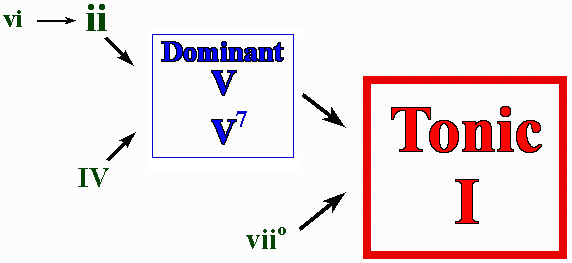
Chord-Leading
One important part of music theory is the idea that certain chords lead to other chords. This concept is very important when writing songs, and therefore I will cover it here. I hope it is helpful to some of you out there. I know this was one of the most helpful aspects music theory for me. Chord leading is the most abstract theory that I cover, so please bear with me. Also, you might want to keep checking the image at the end, which explains all the fundamental leading principles explained in the text.
As you already know, chords in each song revolve around the tonic chord of the key. This chord shares the name of the key, so in the key of G the tonic is G. But when we say "revolve" what do we mean? Well, in a way, each of the other chords are floating out in space trying to get back to the tonic. Some of them do not lead directly to the tonic, but get there through other chords. This sets up the chord progression of a song: which chord does the current chord lead to? I'm not saying that these chords must always follow each other, because that would make music pretty darn boring, but chord leading is a very powerful technique that can give meaning and resolution to a chord progression.
All of the examples I use on this page are in the key of G. So when I mention a chord, I am referring to its position in the key of G.
Chords That Resolve to the Tonic (I)
The second most important chord in any song is the dominant, or fifth (D in the key of G). This chord resolves to the tonic because it contains the leading tone. For example, in the key of G, the dominant D chord contains D, F#, and A; the F# leads to the G. Obviously this does not mean that the dominant can only move to the tonic, it means that to end a piece of music, a V-I progression is a very good choice. Try playing D-G over and over to see how well D resolves to G.
The dominant seventh chord (V7) also resolves to the tonic, in fact it resolves better than the dominant alone. This is because while the leading tone (in this case F#) still resolves one half-step up to the tonic G, the seventh (C) resolves down one half-step to B, which is the third of the G chord (G, B, D). Play D7-G several times to hear what I am talking about. One thing to mention: when resolving D7-G, play the G like this: 320003, because then the C-B resolution can be heard better. Because V7-I is such a strong ending, it is used very often in popular songs.
The diminished seven chord (viiș) also leads strongly to the tonic. This chord, almost without exception, is resolved to the tonic. However, viiș chords are not often encountered in popular music, so they are rather unimportant.
Chords That Resolve to the Dominant (V)
The second (ii) leads very strongly to the dominant. This is because of an abstract theory idea: just as the dominant moves to the tonic, the second (which is, in a sense, the "dominant" of the dominant) moves toward the dominant. Therefore, Am-D-G is a very solid ending and is used very frequently in music. Play this several times to see how it sounds.
The fourth (IV) also leads to the dominant, but not as strongly as the second. Play C-D-G (IV-V-I) and you will find that it sounds very good.
Chords That Resolve to the Second (ii)
The sixth (vi) is the only chord left with any reasonable leading tendencies. The sixth leads to the second, for the same reasons cited before for other chords: it is the "dominant" of the second. A good way to resolve the use of an Em chord is to follow it up with an Am chord.
The Remaining Chords
The only chord left is the third (Bm in G). The leading qualities of this chord are very limited. Basically it can move to any other chord, and is not frequently used.
The Tonic?
You may ask: what happened to the tonic in all this? You have all these chords which eventually lead to the tonic but what happens once you get there? Well, anything can happen. The tonic leads to any other chord. Since it is the center of stability in a key, any other chord will be less stable and therefore you can progress anywhere from it.
That's it for leading chords. This is a very useful technique, and it should help you to write songs or understand music better. I hope it has been helpful, and just to outline what I've said in a clearer manner I have put together the following diagram. Good luck, and enjoy!
Chord Leading Outline

Back to Dansm's Guitar Chord Theory
You are visitor number
© 1997 Daniel E. Smith.